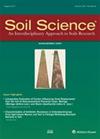Effects of returning corn straw and fermented corn straw to fields on the soil organic carbon pools and humus composition
4区 农林科学
Q2 Agricultural and Biological Sciences
引用次数: 5
Abstract
Abstract. In our previous studies, we filtered out fungus (Trichoderma reesei) to have the best ability to transform corn straw into a humic acid-like substance through laboratory incubation experiments. In order to further verify our former findings, we set up a 360 day-field experiment that included three treatments applied under equal C mass: (i) corn straw returned to the field (CS), (ii) fermented corn straw treated with Trichoderma reesei returned to the field (FCS-T), and (iii) blank control treatment (CK). Soil organic carbon (SOC), soil labile organic C components, soil humus composition, and the management levels of SOC pools under the three treatments were analyzed and compared. The results showed that the SOC content of CS and FCS-T treatments increased by 12.71 % and 18.81 %, respectively, compared with CK at 360 d. The humic acid carbon (HA-C) content of the FCS-T treatment was 0.77 g/kg higher than in the CS treatment. Application of FCS-T appeared to promote the significant increase of SOC, carbon pool activity index (CPAI) and carbon pool management index (CPMI) through accumulation of HA-C, humin carbon (HM-C), and easily oxidizable organic carbon (EOC) contents. Application of fermented corn straw treated with Trichoderma reesei (FCS-T) is more valuable and conducive to increasing soil EOC and humus C content than direct application of corn straw.玉米秸秆和发酵玉米秸秆还田对土壤有机碳库和腐殖质组成的影响
摘要在我们之前的研究中,我们通过实验室培养实验筛选出了将玉米秸秆转化为腐植酸样物质的能力最好的真菌(Trichoderma reesei)。为了进一步验证我们之前的发现,我们建立了一个360天的田间试验,包括在相同C质量下施用三种处理:(i)玉米秸秆还田(CS), (ii)发酵玉米秸秆用里氏木霉还田(FCS-T), (iii)空白对照处理(CK)。分析比较了3个处理下土壤有机碳(SOC)、土壤活性有机碳组分、土壤腐殖质组成和土壤有机碳库管理水平。结果表明,在360 d时,CS和FCS-T处理的土壤有机碳含量分别比CK提高了12.71%和18.81%。FCS-T处理腐殖酸碳(HA-C)含量比CS处理高0.77 g/kg。FCS-T通过积累HA-C、人类碳(HM-C)和易氧化有机碳(EOC)含量,促进了土壤有机碳(SOC)、碳库活性指数(CPAI)和碳库管理指数(CPMI)的显著提高。施用里氏木霉发酵玉米秸秆比直接施用玉米秸秆更有价值,更有利于提高土壤EOC和腐殖质C含量。
本文章由计算机程序翻译,如有差异,请以英文原文为准。
求助全文
约1分钟内获得全文
求助全文
来源期刊

Soil Science
农林科学-土壤科学
CiteScore
2.70
自引率
0.00%
发文量
0
审稿时长
4.4 months
期刊介绍:
Cessation.Soil Science satisfies the professional needs of all scientists and laboratory personnel involved in soil and plant research by publishing primary research reports and critical reviews of basic and applied soil science, especially as it relates to soil and plant studies and general environmental soil science.
Each month, Soil Science presents authoritative research articles from an impressive array of discipline: soil chemistry and biochemistry, physics, fertility and nutrition, soil genesis and morphology, soil microbiology and mineralogy. Of immediate relevance to soil scientists-both industrial and academic-this unique publication also has long-range value for agronomists and environmental scientists.
 求助内容:
求助内容: 应助结果提醒方式:
应助结果提醒方式:


